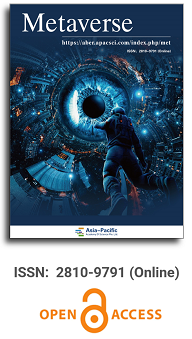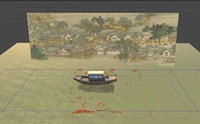
Asia Pacific Academy of Science Pte. Ltd. (APACSCI) specializes in international journal publishing. APACSCI adopts the open access publishing model and provides an important communication bridge for academic groups whose interest fields include engineering, technology, medicine, computer, mathematics, agriculture and forestry, and environment.


Issue release: 31 December, 2023
People are getting more and more familiar with the concept of “Metaverse” as a result of the advanced technologies that are developing at a rapid pace. Though it incorporates many current technologies, such as 5G, cloud computing, artificial intelligence, virtual reality, blockchain, digital currency, the Internet of Things, and human-computer interaction, the Metaverse itself does not contain any new technology[1]. The Metaverse is the carrier of the next generation of social worlds, having developed a new environment in which people are virtually connected to their loved ones, pets, favorite things, and experiences[2]. Everyday lifeworld is being impacted by the Metaverse these days, and there are a lot of interesting and absorbing things to investigate and study. This issue offers readers an intriguing look into research on the Metaverse from a variety of perspectives, with the primary focus being on art production via Metaverse-related technologies. In addition, scholars try to take various technologies associated with the Metaverse into the consideration of objective reality of the digital age. It is envisaged that those subjects will stimulate readers’ curiosity and encourage their active Metaverse investigation.
Issue release: 31 December, 2023
Reconstructing a 3D human body from a single image is convenient and efficient, but it faces challenges when the face is heavily occluded or the person is wearing loose clothing. In this paper, we propose a frequency domain-based method for completing missing parts of the human body using manifold harmonics and frequency domain analysis. Our approach involves linear interpolation of the incomplete 3D human body obtained through normal integration. The interpolated points are then projected onto the appropriate dimension of the frequency domain space using manifold harmonic bases. Through Laplacian mesh editing, the interpolated points are replaced, resulting in a refined and complete 3D human body. Our method surpasses the limitations of template human bodies and marching cubes algorithms, enabling more detailed feature reconstruction. By locally completing the body in a low-dimensional frequency domain space, our method avoids over smoothing and bulging issues, effectively filling the missing regions while maintaining mesh smoothness consistency. Experimental results demonstrate the effectiveness and superiority of our frequency domain-based completion method for accurate and detailed 3D human body reconstruction from single images.
Issue release: 31 December, 2023
Immersive cultural performances with virtual-real fusion effects are the future development trend in the exhibition and stage industry. However, current virtual-real stage performances heavily rely on traditional sequential design and arrangements. During the performance, actors must move to specific positions based on the musical beat and execute predetermined actions with a pre-designed amplitude and frequency to synchronize with the fixedly played stage visual effects; otherwise, major performance accidents such as plot inconsistencies or continuity errors may occur. To address the problem, this paper introduces a real-time generation system for stage visual effects based on multi-view multi-person 3D motion capture. The system utilizes multi-view 3D motion capture technique to achieve non-intrusive real-time interaction perception of target actors in the stage space. By perceiving the spatial position and performance actions of the target actors, corresponding stage visual effects are generated in real-time. This is followed by the seamless integration of sound effects and immersive high-definition display, ultimately realizing multidimensional real-time interaction between real actors and virtual visual effects in the stage space. We conducted an experimental virtual-real stage performance, lasting approximately two minutes, in a physical theater to validate the effectiveness of our proposed method. The experiment not only produced a unique innovative effect of blending stage and technology but also effectively enhanced the sense of presence and interactivity of the stage performance, providing actors with more freedom and control in their performances.
Issue release: 31 December, 2023
This study investigated the possible effect of varying levels of interaction fidelity (IF) in virtual reality (VR) games on several beneficial outcomes, including stress relief, calories burned, spatial presence, and enjoyment. Players were asked to play one of three VR games with varying IF levels. Results indicated that interaction fidelity was not a significant factor in these outcomes except for enjoyment; the high IF game was enjoyed more than the low IF game. However, playing any game did have a significant, if small, impact overall on both stress relief and calories burned. The results are encouraging due to the indication that spending time in VR and metaverse applications may have small but inherent health benefits.
Issue release: 31 December, 2023
The confluence of extended reality (XR) technologies, including augmented and virtual reality, with large language models (LLM) marks a significant advancement in the field of digital humanities, opening uncharted avenues for the representation of cultural heritage within the burgeoning metaverse. This paper undertakes an examination of the potentialities and intricacies of such a convergence, focusing particularly on the creation of digital homunculi or changelings. These virtual beings, remarkable for their sentience and individuality, are also part of a collective consciousness, a notion explored through a thematic comparison in science fiction with the Borg and the Changelings in the Star Trek universe. Such a comparison offers a metaphorical framework for discussing complex phenomena such as shared consciousness and individuality, illuminating their bearing on perceptions of self and awareness. Further, the paper considers the ethical implications of these concepts, including potential loss of individuality and the challenges inherent to accurate representation of historical figures and cultures. The latter necessitates collaboration with cultural experts, underscoring the intersectionality of technological innovation and cultural sensitivity. Ultimately, this chapter contributes to a deeper understanding of the technical aspects of integrating large language models with immersive technologies and situates these developments within a nuanced cultural and ethical discourse. By offering a comprehensive overview and proposing clear recommendations, the paper lays the groundwork for future research and development in the application of these technologies within the unique context of cultural heritage representation in the metaverse.
Issue release: 31 December, 2023
This paper explores the complexities of objective reality in the digital era, using André Bazin’s theory of realism as a lens. As digital advancements, such as deepfakes and immersive technologies, blur the boundaries between the tangible and virtual, they prompt a re-evaluation of Bazin’s principles on the ‘ontology of the photographic image’. The study critically examines how these digital innovations both challenge and enrich Bazin’s notions of unmediated representation, underscoring the need for a contemporary dialogue on the implications of digital technologies for our understanding of truth and reality.
Issue release: 31 December, 2023
The paper briefly describes the inclusive school places the greatest emphasis on inclusive innovation, which revolves around fostering knowledge of media arts. The main goal is to investigate and analyze the incorporation of the metaverse through the complementary subject of media arts for inclusive educational purposes. This proposal was allowed to incorporate the virtual and three-dimensional environment used for students and teachers, exploring and interacting with various digital worlds. The analysis of the results was carried out through the contents of the Venn diagram and additional creation, attending to criteria of investigative interest of inclusive metaverse to demonstrate and represent the new preliminary ideas through the educational development of media arts and virtual environments. There are debates about the analysis of inclusive metaverse as the most advanced engineering and artistic technology project, which allows you to incorporate the methodological proposal associated with the complementary subject of media arts together with the interactive tools, making visible in materiality more complex didactics of students of different levels of school education in general. In conclusion, the methodological proposal of media arts for the inclusive metaverse, each student, each teacher, or each educational system could transform the next generation of participation and motivation towards school, depending on the artistic and technological expression that students had learned by using educational gamification, that is, they are better prepared to face the art technology and challenges of the future, bringing with them a spirit of innovation and collaboration, marking a path in the world of digital art.
Issue release: 31 December, 2023
The core characteristic of new media literature that differs from traditional print-era literature can be summarized as “digital artistry”. Based on the Cheng Guang interactive platform, the Cheng Guang literature adopts a typical hypertext model and shows a certain degree of representativeness in the creation of digital artistry. Life Reboot fully utilizes the constructive functions of the three elements of hypertext—node, link, and network—to produce aesthetic effects that are different from those of traditional literary works—digital artistry such as composite symbolic text, interactive narrative, and ontolepsis. The use of the three elements of hypertext enables readers to break through the limitations of reality, travel through multi-dimensional space and “parallel universes”, realize a life reboot, reach multiple possible lives, and obtain aesthetic experiences that traditional literary works cannot provide.
Issue release: 31 December, 2023
Virtual reality departs from and transcends reality, and the VR reset of “The Legend of Sword and Fairy I” aggregates the complete industrial ecology formed by the extended development of old game IP and the VR blue ocean commercial market. From two-dimensional to VR, the digital technology field has shaped the virtual embodied world where traditional culture and modernity are intertwined, and constructed the “Immortal Sword World” that gathers, condenses and reshapes the national complex, cultural consciousness and modern discourse. A series of physical operations enables players to interact with the “Immortal Sword World” in real time and in a natural way. The absolute and unique rules and mechanisms of “The Legend of Sword and Fairy I” VR create a 3D community discourse field with an entire new social system + technical system. The open interactive architecture of “Immortal Sword World” provides a meta-statement for free exploration, ideally presenting the pre-determined sequence of the immersive “Immortal Sword World” and allowing players to open up an imaginary future dreaming space in a step beyond reality.
Issue release: 31 December, 2023
The purpose of this article is to take “Killing a Superstar” as a typical example, to denmonstrate how VR technology generates VR film via virtualizing 3D world from aesthetic perspective, and to give a critical reflection of VR film. The article includes three parts. The first part is about how the film utilizes VR as a technical premise for the implement of interactive narrative, constructing the audio-visual space with panoramic photography, and generating the virtual world with digital programs. Its interactive mode renders human-computer dialogue feasible, and realizes the connection between human and virtual reality with VR playback equipment. The second part is carried out under a further analysis of the artistic dimension of the film. In this section, it’s pointed out that the active narrative perspective of the audience, the multilinear narrative structure of time and space, the embodied and remote experience of perception, and the prominent guiding narrative processing, are all combined together for the sake to present interactive narrative art expression of virtual world. And the final part tries to reflect and evaluate on VR film in a broader vision. From both technical and artistic viewpoints, VR film is a breakthrough and innovation compared to traditional film model, although it surely has some drawbacks and limitations. If it can be considered more in a sense of establishing interactable virtual world then stroytelling, it is likely to develop into a more significant VR image art in the future.
Issue release: 31 December, 2023
The constant renewal and development of emerging technologies and new media offer more possibilities for the innovation and development of sound art. ASMR (autonomous sensory meridian response), as a new product of auditory culture, is an example of the innovative development of literature and art in the context of the fusion of new technologies and new media. The dependence on the medium is a prominent feature of this kind of auditory art, and the background conditions and unique aesthetic implications of ASMR auditory art offer the possibility of a shift towards auditory culture.

Prof. Zhigeng Pan
Director, Institute for Metaverse, Nanjing University of Information Science & Technology, China

Prof. Jianrong Tan
Academician, Chinese Academy of Engineering, China
Platform: VooV Meeting Meeting ID: 688-583-586...


 Open Access
Open Access



.jpg)
.jpg)

